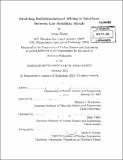| dc.contributor.advisor | Michael J. Demkowicz. | en_US |
| dc.contributor.author | Zhang, Liang, Ph. D.. Massachusetts Institute of Technology | en_US |
| dc.contributor.other | Massachusetts Institute of Technology. Department of Nuclear Science and Engineering. | en_US |
| dc.date.accessioned | 2014-05-23T19:37:46Z | |
| dc.date.available | 2014-05-23T19:37:46Z | |
| dc.date.copyright | 2014 | en_US |
| dc.date.issued | 2014 | en_US |
| dc.identifier.uri | http://hdl.handle.net/1721.1/87493 | |
| dc.description | Thesis: Ph. D., Massachusetts Institute of Technology, Department of Nuclear Science and Engineering, 2014. | en_US |
| dc.description | Cataloged from PDF version of thesis. | en_US |
| dc.description | Includes bibliographical references (pages 123-139). | en_US |
| dc.description.abstract | This thesis studies radiation-induced mixing at interfaces between low solubility metals using molecular dynamics (MD) computer simulations. It provides original contributions on the fundamental mechanisms of radiation-induced mixing and morphological stability of multilayer nanocomposites under heavy ion or neutron radiation. An embedded atom method (EAM) interatomic potential is constructed to reproduce the main topological features of the experimental equilibrium phase diagram of the Cu-Nb system in both solid and liquid states. Compared with two previously available EAM Cu-Nb potentials, the phase diagram of the current potential shows better agreement with the experimental phase diagram. The newly constructed potential predicts that the Cu-Nb liquid phase at equilibrium is compositionally patterned over lengths of about 2.3 nm. All three Cu-Nb potentials have the same solid phase behavior but different liquid phase properties, serving as a convenient set of model systems to study the effect of liquid phase properties on radiation-induced mixing. To study radiation-induced intermixing, a specialized MD simulation is developed that models multiple 10 keV collision cascades sequentially up to a total dose of ~5 displacements per atom (dpa). These simulations are comparable to experiments conducted at cryogenic temperatures. Mixing is modeled using all three Cu-Nb potentials and found to be proportional to the square root of dose, independent of interface crystallography, and highly sensitive to liquid phase interdiffusivity. It occurs primarily by liquid phase interdiffusion in thermal spikes rather than by ballistic displacements. Partial de-mixing is also seen within thermal spikes, regardless of liquid phase solubility, which is explained by segregation of impurities into the liquid core of the thermal spikes. Additional MD and phase field simulations are carried out on Cu-Nb multilayered nanocomposites with individual layer thicknesses above 1 nm. These simulations demonstrate that Cu-Nb multilayers with individual layer thicknesses above 2-4 nm remain morphologically stable when subjected to 100 keV collision cascades, characteristic of neutron or heavy ion irradiation. The probability of morphological instability rapidly increases as the layer thickness decreases to 1 nm, which is due to overlap of zones of liquid-like interdiffusion inside radiation-induced thermal spikes at neighboring interfaces in the multilayer. This work shows that to design morphologically stable radiation-tolerant nanocomposites, it is desirable to a) choose low solubility metals with small liquid phase interdiffusivity as the constituents, and b) use a microstructural length scale larger than twice the size of the interdiffusion zone inside thermal spikes. | en_US |
| dc.description.statementofresponsibility | by Liang Zhang. | en_US |
| dc.format.extent | 139 pages | en_US |
| dc.language.iso | eng | en_US |
| dc.publisher | Massachusetts Institute of Technology | en_US |
| dc.rights | M.I.T. theses are protected by copyright. They may be viewed from this source for any purpose, but reproduction or distribution in any format is prohibited without written permission. See provided URL for inquiries about permission. | en_US |
| dc.rights.uri | http://dspace.mit.edu/handle/1721.1/7582 | en_US |
| dc.subject | Nuclear Science and Engineering. | en_US |
| dc.title | Modeling radiation-induced mixing at interfaces between low solubility metals | en_US |
| dc.type | Thesis | en_US |
| dc.description.degree | Ph. D. | en_US |
| dc.contributor.department | Massachusetts Institute of Technology. Department of Nuclear Science and Engineering | |
| dc.identifier.oclc | 879667534 | en_US |
